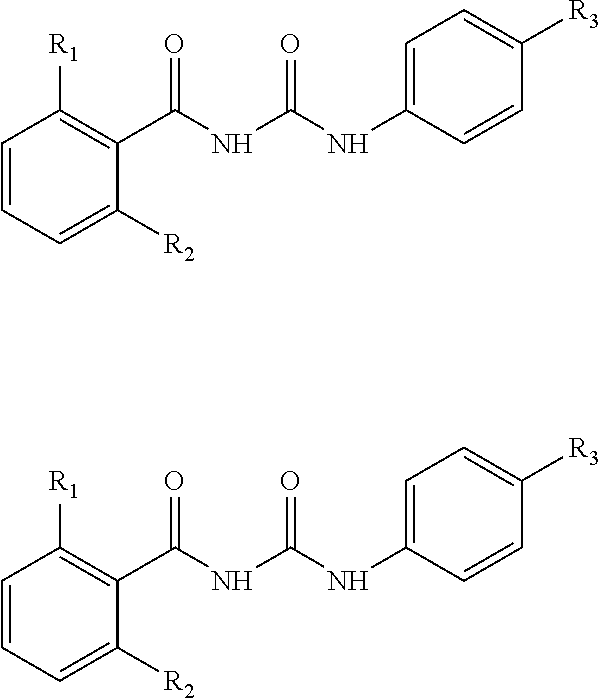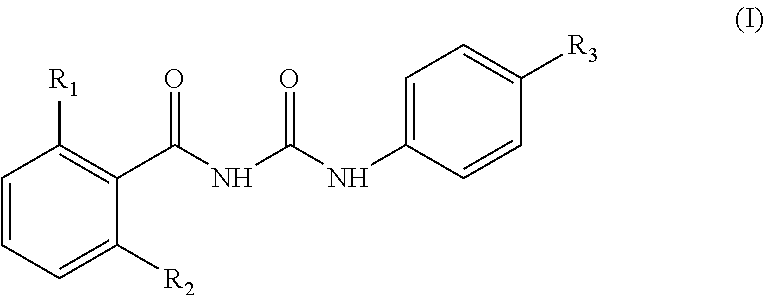Veterinary Compositions For Controlling Ecto- And Endoparasites In Bovines, Use Of These Compositions, Use Of IGR Substances Associated With Microminerals, Method For Controlling Ecto- And Endoparasites In Bovines And Kit
Active Publication Date: 2014-03-06
CHAMPION FARMOQUIMICO
View PDF2 Cites 4 Cited by
- Summary
- Abstract
- Description
- Claims
- Application Information
AI Technical Summary
Benefits of technology
The present invention is a veterinary composition that can be in solid form, such as a powder or pellet, and can be added to the feed or mineral supplement of animals. The composition contains at least one insect growth regulator (IGR) compound and a micromineral mix. The IGR compounds can be selected from a group of compounds, including but not limited to, diflubenzuron, cyromazine, triflumuron, methoprene, and others. The micromineral mix can include iron, copper, cobalt, manganese, zinc, iodine, selenium, and chromium. The composition can be effective against ecto- and endoparasites, such as Haemonchus spp., Rhipicephalus (Boophilus) microplus, and others. The composition can be used in solid form or as a powder or pellet for easy addition to animal feed or mineral supplement. The composition can be made by mixing the ingredients together using conventional mixing equipment. The composition can be used to control parasites in animals, preventing them from causing harm to human health in meat or milk. The micromineral mix includes minerals found in trace amounts in an animal's body or required in smaller amounts in the diet. The composition can be effective against ecto- and endoparasites, reducing their population.
Problems solved by technology
Other losses include, directly, as consequences of tick bites: irritability, blood loss leading to weight loss and reduced dairy production, secondary infestations (myiasis) and damaged hides.
Among indirect losses are increased labor costs, cost of acaricides, environmental losses due to the use of such substances and its residues in animal products (ANDREOTTI & GOMES, 2003) since the non-compliance of the withdrawal period forbids human consumption (FURLONC & PRATA, 2006), and the risk of intoxication by long time exposure, that could lead to teratogenic or / and carcinogenic effects on man (ROJAS et a / ., 2000 quoted by SILVA, 2001).
Nowadays, cattle tick control is a real challenge to livestock economics.
A roundup is an extremely laborious activity that involves many people and has a long duration.
During a roundup, animals cannot feed, are subjected to stress, can be harmed by handlers or by escape attempts, and suffer considerable weight loss.
Beyond all those losses, the herding of animals to the corral leads to a disorganization of their activities (PARANHOS DA COSTA & NETO, 2003), and that can lead to weight loss up to 15 kg per roundup (ARENALES, 2004).
Stressful roundup activities raise the risk of accidents, which may lead to bruised carcasses (PARANHOS DA COSTA et al., 2004).
However, it has the disadvantage of not being indicated for use on lactating cows.
Another great disadvantage of existing products is that lots of them leave toxic chemical residues on both beef and dairy cattle.
The resulting pain and annoyance interferes with feeding, resting and the other normal activities of cattle.
The eggs are reddish-brown and difficult to detect in the manure.
The irritation and blood loss cause cattle to lose 0.3 to 0.5 lbs. per day and for dairy animals cause lower milk production.
Large populations of horn flies may cause open sores on the head and underline which can predispose their hosts to secondary infections of both disease and parasites.
Their close association with cattle makes them susceptible to chemical control measures.
Back rubbers can also give control but are usually less successful on horn flies.
The main disadvantage of these methods is that they require the herd to be brought into the corral.
As discussed above, handling the animals inside the corral is a major source of costs to the rancher.
While sprays are generally easy to apply, several applications may be needed because their duration of control is often limited (3 to 4 weeks).b) Pour-on: These insecticides are ready-to-use formulations that are applied in measured doses to animals based upon body weight.
Generally, ear tags are more effective against insects such as horn flies that spend the majority of their life on the animal and are less effective or ineffective against insect pests that are on the animal for a short period of time (e.g., mosquito, deer fly, horse fly).
However, this initial success was short-lived.
Forced-use of dust bags is often not practical with range cattle because they may obtain water from stock ponds or streams.
The products listed above (with the exception of oral additives and boluses) have reduced efficiency, because they are capable of attecting only the adult horn fly population, since they're applied in a topical fashion.
Therefore, those products have no preventive action against the development of the larvae.
As for the bolus, its application requires specific tools (like the balling gun) and experience, since failure to apply it correctly can lead to the animal suffocating.
Additionally, introducing the gun and administering the bolus for each head of cow is an extremely time-consuming and costly activity.
There are some excerpts throughout the patent that point to pure IGR forms as feed additives (instead of compounds containing IGR as active ingredients), which happens to be a somehow inefficient way of treating cattle.
The addition of pure form IGR can undermine insect control efficiency.
The L-3 have a protective cuticle, however under dry hot conditions will not survive long.
The nematode piercing the abomasum causes a number of significant complications in the infected ruminants that can lead to death.
The infected animals can display severe dehydration, diarrhea, unthrifty appearance, lethargy, depressed low energy behavior, rough hair coat and uncoordinated movements.
Furthermore, significantly reduced growth and poor reproductive performance has been observed.
The infection, called Haemonchosis, causes large economic losses for farmers around the world, especially for those living in the warmer climates.
Existing anthelmintics work by killing the adult forms and immature species by means of its toxic effect, although they don't possess enough residual power that leads to re-infestation cycle elimination.
Moreover, existing anthelmintics leave toxic residues on beef and milk of the treated animals, and are more likely to be affected by anthelminthic resistance.
It is an inconvenient truth that reports of resistance are no longer noteworthy; anthelmintic resistance is the status quo.
Thus, in some regions, high levels of multiple-drug resistance threaten the health and productivity of these species as well.
However, the development of new anthelmintic drug classes is not likely to solve the problem of anthelmintic resistance.
The great cost associated with the development of new drugs and the trends of reduced levels of investment into new animal drug research over the past few decades make it extremely unlikely that we are entering a new phase where a continuous supply of new anthelmintic compounds will follow (Geary et al., 2004).
In all three studies injectable avermectin / milbemycin products were used, with data indicating that resistance is becoming a very serious problem in these regions.
This particular mechanism doesn't lead to resistance among parasites, which is the major issue regarding common anthelmintic drugs.
Method used
the structure of the environmentally friendly knitted fabric provided by the present invention; figure 2 Flow chart of the yarn wrapping machine for environmentally friendly knitted fabrics and storage devices; image 3 Is the parameter map of the yarn covering machine
View moreImage
Smart Image Click on the blue labels to locate them in the text.
Smart ImageViewing Examples
Examples
Experimental program
Comparison scheme
Effect test
example 1
Composition According to the Present Invention
[0107]Each 1,000 g of the present invention contains:
Iron sulfate763.55gCopper sulfate60.0gCobalt sulfate30.0gManganese sulfate30.0gPotassium iodate20.0gZinc Oxide10.0gSodium selenite2.2gChromium oxide1.6gTechnical diflubenzuron82.65g
the structure of the environmentally friendly knitted fabric provided by the present invention; figure 2 Flow chart of the yarn wrapping machine for environmentally friendly knitted fabrics and storage devices; image 3 Is the parameter map of the yarn covering machine
Login to View More PUM
| Property | Measurement | Unit |
|---|---|---|
| Percent by mass | aaaaa | aaaaa |
| Percent by mass | aaaaa | aaaaa |
| Mass | aaaaa | aaaaa |
Login to View More
Abstract
Veterinary compositions are described for controlling ecto- and endo-parasites in animals, such as bovine. The compositions contain an IGR compound(s) or a benzoyl substituted urea(s) along with a mineral mix and at least one carrier.
Description
FIELD OF INVENTION[0001]The present invention regards a veterinary composition, preferably in the form of dust or powder, as an IGR (insect growth regulator) compound-based feed and / or mineral supplementation additive (rock salt, mineral salt, vitamin concentrates, among others), or particularly substituted benzoyl urea-based, associated with microminerals, to simultaneously control ecto- and endoparasites, preferably cattle ticks and horn flies (ectoparasites) and Haemonchus spp. (endoparasite) in bovines.INVENTION BACKGROUNDCattle Tick[0002]Cattle tick (Rhipicephalus [Boophilus] microplus) is the main ectoparasite of cattle present in subtropical and tropical regions.Cattle Tick Cycle[0003]This arthropod's life cycle can be divided in two phases: parasitic and free-living.[0004]Newly attached seed ticks (larvae) start feeding and molt twice, to become nymphs and then adults. Each developmental stage (larva, nymph and adult) feeds only once, but the feeding takes place over several...
Claims
the structure of the environmentally friendly knitted fabric provided by the present invention; figure 2 Flow chart of the yarn wrapping machine for environmentally friendly knitted fabrics and storage devices; image 3 Is the parameter map of the yarn covering machine
Login to View More Application Information
Patent Timeline
 Login to View More
Login to View More IPC IPC(8): A61K31/17A61J1/20A61P33/00A61K33/24
CPCA61K31/17A61K33/04A61K33/18A61K33/24A61K33/26A61K33/32A61K33/34A61P33/00A61K2300/00A01N47/34
Inventor DA ROCHA, FLAVIO ALVES
Owner CHAMPION FARMOQUIMICO
Features
- R&D
- Intellectual Property
- Life Sciences
- Materials
- Tech Scout
Why Patsnap Eureka
- Unparalleled Data Quality
- Higher Quality Content
- 60% Fewer Hallucinations
Social media
Patsnap Eureka Blog
Learn More Browse by: Latest US Patents, China's latest patents, Technical Efficacy Thesaurus, Application Domain, Technology Topic, Popular Technical Reports.
© 2025 PatSnap. All rights reserved.Legal|Privacy policy|Modern Slavery Act Transparency Statement|Sitemap|About US| Contact US: help@patsnap.com


